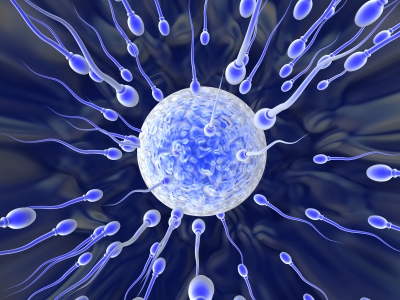Sperm Prefer Attractive Females

I don't make this stuff up, promise. I just find it and pass it along for your perusal: "Males may alter the velocity of sperm they allocate to copulations by strategically firing their left and right ejaculatory ducts, which can operate independently."
And what leads to that double firing?
Among red junglefowl, it's attractive females that do the trick, according to an article at Discovery.com this week.
Similar sperm-control mechanisms have been uncovered previously. In fact, "sperm competition" is a well-supported idea that goes way back. As often put, for males it's like trying to win the lottery: The more tickets you have, the greater your chances. But, of course, each ticket has a price.
Targeted effort
Sperm are excellent at swimming and sniffing out their target. For the males of many species, success depends on getting the sperm to the target more effectively than the competition — monogamy is rare in the animal kingdom. Producing more sperm, or sperm that swim faster, or sperm that can beat the crap out of other sperm, ups your odds of passing on your genes.
"Paternity is determined by the competitive ability of a male to access females and by the ability of its ejaculates to out-compete those of other males over fertilization," wrote Tommaso Pizzari of the University of Oxford and colleagues a couple years back in the journal Proceedings of the Royal Society B: Biological Sciences.
Sign up for the Live Science daily newsletter now
Get the world’s most fascinating discoveries delivered straight to your inbox.
In recent years, scientists have found a plethora of strategies for altering ejaculates "on a copulation-by-copulation basis, depending on their assessment of immediate sperm competition risk," as Olivia Judson put it in The New York Times last year. Examples:
- Pizzari and colleagues found that a particular type of fowl (Gallus gallus domesticus) adjusts sperm quality based on social factors, such as how they did in their last encounter with a female.
- A 2007 study at the University of Western Australia found male crickets "produced ejaculates with a greater percentage of live sperm when they had encountered a rival male prior to mating."
- Copulating cockerels tailor their ejaculate based on multiple factors: the degree of male competition; whether they have mated with the female before; and the female's reproductive "value," according to a study published in the journal Nature in 2003.
- Among fruit flies, proteins in semen evolve as fast as the immune system to help males compete for paternity, scientists found last year.
However, ramping things up comes at no small cost. The energy needed to produce more or faster sperm means the productive male has less energy than the next guy for other things — like eating or running away from predators or chasing down a female.
"Sperm and ejaculate production are inevitably associated with costs, which at times can directly limit male mating rates," explained Nina Wedell of the University of Exeter in a 2007 article in the Society of Reproduction and Fertility supplement. "As a consequence of sperm limitation, males are expected to strategically allocate their ejaculates to maximize fertilizations."
Tough job, yada, yada. But how, exactly, is that accomplished?
"Males are sensitive to cues relating to varying levels of sperm competition and female fecundity and modulate their ejaculates accordingly," Wedell writes.
What about humans?
Do human males do this too? Nobody knows for sure. It's likely that some level of sperm competition is at work in men, given this stark truth: Each ejaculation produces about 250 million sperm, all aiming for one egg.
But as Judson points out, it's a little tricky to run the necessary experiments on people to learn whether and how their sperm are duking it out. There seems to be no convincing evidence out there for specific examples of how human males might control sperm for competitive advantage.
One idea that's been floating around for years: Humans have "kamikaze sperm" whose sole aim is to knock out the other guy's sperm, should any be there. Evidence doesn't support this popular but apparent myth, however, though it persists because it sounds cool.
Either way, guys, relax. There's not much you can do about any of this. Sperm competition in animals is thought to be an involuntary action, like the beating of a heart or the mobilization of the immune system or, well, that thing that happens upon delivery of said sperm.
Here's an interesting, related, longstanding hypothesis worthy of a closing statement: The human penis evolved, shape-wise, to compete with sperm from other males by knocking rival semen out of the cervical end of the vagina before ejaculation.
- 10 Surprising Sex Statistics
- 5 Myths about Women's Bodies
- Evolution News
In The Water Cooler, Imaginova's Editorial Director Robert Roy Britt looks at what people are talking about in the world of science and beyond. Find more in the archives and on Twitter.
Robert is an independent health and science journalist and writer based in Phoenix, Arizona. He is a former editor-in-chief of Live Science with over 20 years of experience as a reporter and editor. He has worked on websites such as Space.com and Tom's Guide, and is a contributor on Medium, covering how we age and how to optimize the mind and body through time. He has a journalism degree from Humboldt State University in California.










